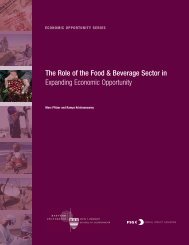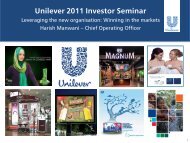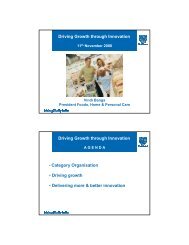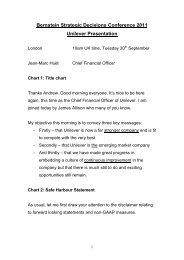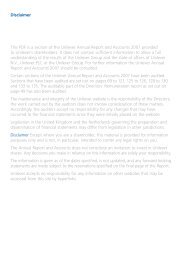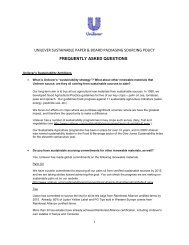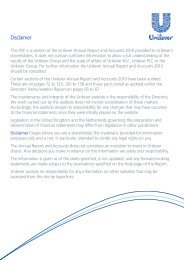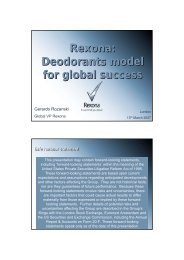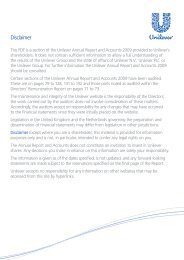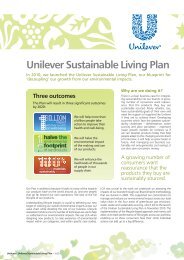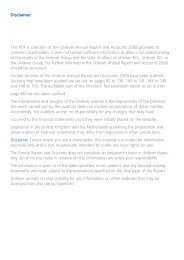2010 first half year results volume momentum sustained - Unilever
2010 first half year results volume momentum sustained - Unilever
2010 first half year results volume momentum sustained - Unilever
You also want an ePaper? Increase the reach of your titles
YUMPU automatically turns print PDFs into web optimized ePapers that Google loves.
(unaudited)<br />
1 ACCOUNTING INFORMATION AND POLICIES<br />
NOTES TO THE FINANCIAL STATEMENTS<br />
The condensed interim financial statements are based on International Financial Reporting Standards (IFRS) as adopted by the<br />
EU and IFRS as issued by the International Accounting Standards Board. The accounting policies and methods of computation<br />
are consistent with the <strong>year</strong> ended 31 December 2009 and are in compliance with IAS34 ‘Interim Financial reporting’.<br />
The condensed interim financial statements are shown at current exchange rates, while percentage <strong>year</strong>-on-<strong>year</strong> changes are<br />
shown at both current and constant exchange rates to facilitate comparison.<br />
The income statement on page 7, the statements of comprehensive income and changes in equity on page 8, the cash flow<br />
statement on page 9, and the analysis of free cash flow on page 14 are translated at rates current in each period.<br />
The balance sheet on page 10 and the analysis of net debt on page 15 are translated at period-end rates of exchange.<br />
The financial statements attached do not constitute the full financial statements within the meaning of Section 434 of the UK<br />
Companies Act 2006. Full accounts for <strong>Unilever</strong> for the <strong>year</strong> ended 31 December 2009 have been delivered to the Registrar of<br />
Companies. The auditors’ report on these accounts was unqualified and did not contain a statement under Section 498 (2) or<br />
Section 498 (3) of the UK Companies Act 2006.<br />
2 NON-GAAP MEASURES<br />
In our financial reporting we use certain measures that are not recognised under IFRS or other generally accepted accounting<br />
principles (GAAP). We do this because we believe that these measures are useful to investors and other users of our financial<br />
statements in helping them to understand underlying business performance. Wherever we use such measures, we make clear<br />
that these are not intended as a substitute for recognised GAAP measures. Wherever appropriate and practical, we provide<br />
reconciliations to relevant GAAP measures. <strong>Unilever</strong> uses ‘constant rate’ and ‘underlying’ measures primarily for internal<br />
performance analysis and targeting purposes.<br />
The principal non-GAAP measure which we apply in our quarterly reporting is underlying sales growth, which we reconcile to<br />
changes in the GAAP measure turnover in notes 4 and 5. Underlying sales growth (abbreviated to ‘USG’ or ‘growth’) reports<br />
turnover growth at constant exchange rates, excluding the effects of acquisitions and disposals. Turnover includes the impact<br />
of exchange rates, acquisitions and disposals.<br />
We also comment on underlying trends in operating margin before the impact of restructuring, disposals and other one-off<br />
items, which we collectively term RDIs, on the grounds that the incidence of these items is uneven between quarterly reporting<br />
periods. Further detail on RDIs can be found in note 3. We also discuss free cash flow, which we reconcile in note 8 to the<br />
amounts in the cash flow statement, and net debt, which we reconcile in note 9 to the amounts reported in our balance sheet<br />
and cash flow statement.<br />
In explaining cash flow performance we refer to the trend of average trading working capital. This metric is used internally,<br />
focusing on average rather than closing positions to ensure consistent performance, whilst excluding the elements of working<br />
capital that operational management cannot influence.<br />
Further information about these measures and their reconciliation to GAAP measures is given on our website at<br />
www.unilever.com/investorrelations<br />
3 SIGNIFICANT ITEMS WITHIN THE INCOME STATEMENT<br />
In our income statement reporting we recognise restructuring costs, profits and losses on business disposals and certain other<br />
one-off items, which we collectively term RDIs. We disclose on the face of our income statement the total value of such items<br />
that arise within operating profit. In our operating review by region and in note 4 we highlight the impact of these items on<br />
our operating margin.<br />
Second Quarter € million Half Year<br />
<strong>2010</strong> 2009 <strong>2010</strong> 2009<br />
RDIs within operating profit:<br />
(134) (203) Restructuring (253) (361)<br />
38 - Business disposals 49 -<br />
- - Impairments and other one-off items - -<br />
(96) (203) Total RDIs within operating profit (204) (361)<br />
11




